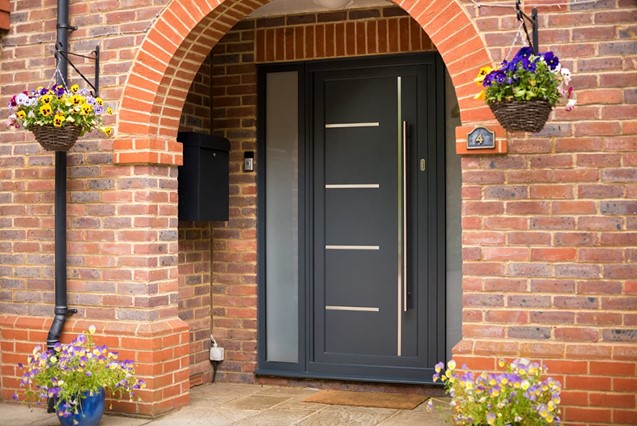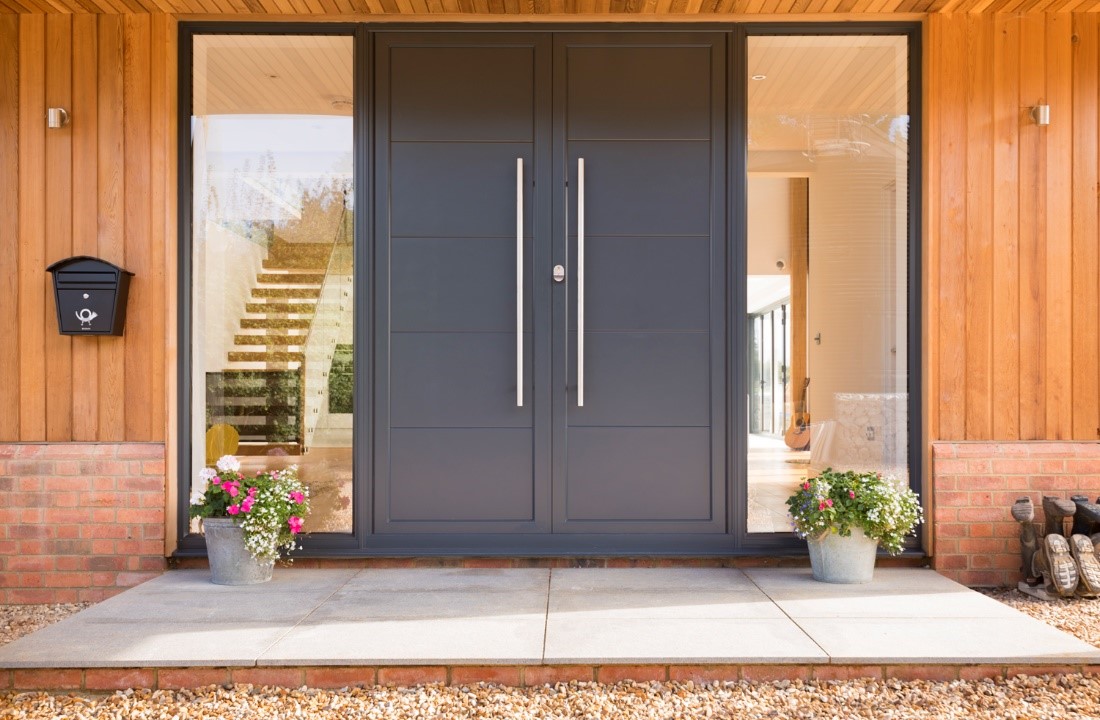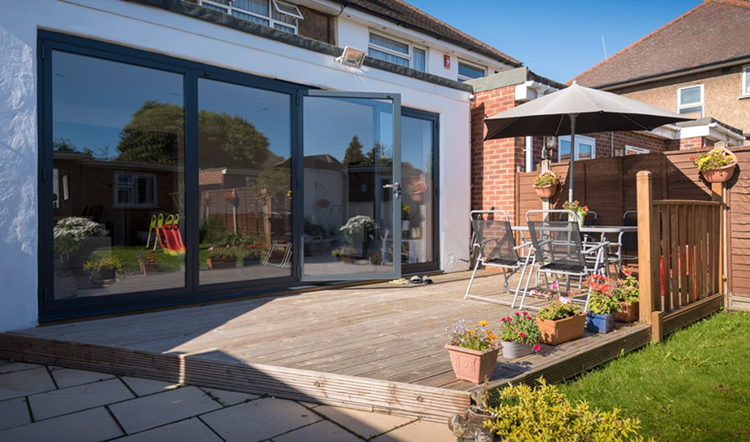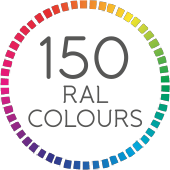A front door is often the first thing guests notice about your home, so it is vital to make sure you choose an eye-catching design that suits the style of your property. Your front door should reflect your own personal style to provide the best first impression of your home. Interior designer, Karen Howes, states, “The front door can say so much about the owner: it can be relaxed and welcoming or more formal”. When choosing a front door, you have various material options to choose from, with popular options being aluminium, composite and wood.
Find out more about the benefits of the different front door materials and how to choose the best option for your home.
Click on a link to jump to that section:
Read our summary of how different front door materials compare to each other.
Find out how aluminium compares to uPVC and why aluminium is a more durable option.
Read the key features and benefits of composite front doors.
Find out more about the vast range of colour options available for aluminium front doors.
Read the key benefits of the Origin Front Door.
A summary: the key differences between popular materials
One of the most important factors you need to decide upon when selecting a new front door is the material of the door panel and frame. It impacts almost all performance features of the door and can also change the aesthetics of your home, so it’s vital to find the best option for you.
There are several different materials to choose from, including aluminium, wood (both engineered and solid), steel, uPVC and composite. The material of the door can indicate its quality, though it should be noted that the actual engineering of the door will always make a difference. There is such a thing as high-quality and low-quality aluminium doors, for example. At Origin, our aluminium is exclusively of a premium grade. This means that it’s not made from re-melting scraps, which gives it a greater overall finish. It’s smooth to the touch and visually flawless to look at. Find out more about the aluminium we use in our front doors here.
Composite doors are certainly a better option than traditional uPVC doors, although neither materials have the strength and high-quality finish found with aluminium doors. To learn more about the differences between composite and aluminium doors, read our comparison of composite and aluminium.
| Wood | Aluminium | Composite | uPVC | |
|---|---|---|---|---|
Strength | Strong. | Very strong. | Quality composite doors are reasonably strong, though not as strong as aluminium or wood. | Weakest of all materials. |
Wear | Can warp, expand and contract when exposed to the elements, compromising the shape and affecting opening and closing. | Resilient to warping or changing shape, not prone to wear. | Often installed with uPVC outer frame, meaning there is a risk of warping, expanding and contracting. | Susceptible to wear from the elements. Will become brittle over time and can discolour. Can warp, expand and contract, affecting shape and opening and closing. |
Maintenance | Wood may need treating for rot, mites or discolouration of the finish. | Low maintenance, other than minimal cleaning every now and again. Quality doors will be finished to ensure they are rust-proof. Do not need retreating. | Reasonably low maintenance. | Reasonably low maintenance, though will look worn quicker than alternatives. |
Insulation & weather-resistance | Reasonably good insulator but can be draughty if doors warp. | Quality aluminium doors with thermal breaks offer excellent efficiency. | Quality composite doors will have reasonable thermal efficiency, but low quality tend to be similar to uPVC. | Varies hugely depending on the provider. |
Aesthetic | Wooden doors tend to look traditional and are available in a wide range of designs. | Available in a wide range of colours and styles. Aluminium looks sleek and contemporary. | Available in woodgrain effect and often in a range of colours. But since they tend to be “off-the-shelf”, the colour and design options are limited. | Tend to only be available in white, which can discolour over time. These doors are considered the least aesthetically pleasing. |
Cost | Varies based on quality, but comparable to aluminium. | Higher cost compared to uPVC or composite. More durable and requires less maintenance, which can save on costs long-term. | Cheaper than aluminium. | The cheapest option available. |
What is the difference between engineered and solid wooden doors?
Engineered wood is sometimes viewed as inferior to solid wood, but this isn’t necessarily the case. Engineered wood is made from several layers of wood pressed together, whereas solid wood is one solid piece, as the name implies. Read about the difference in performance between solid and engineered wood here.
Why are aluminium doors better than wooden doors?
High-quality wooden and aluminium doors will both perform well, but there are some unique advantages offered by aluminium that wooden doors can’t compete with.
The main differences come down to:
- Maintenance
- Warping, expanding and contracting
- Insulation.
Some wooden doors require a lot of maintenance, and most will need retreating at some point to keep the wood in good order. If they are not maintained sufficiently, they can become vulnerable to warping and changing shape because moisture can get into the grains of the wood. Wood can also become infested with mites if not treated regularly. However, moisture cannot get into aluminium.
Find out more about the benefits of aluminium here.
Although quality wooden doors will come with good finishes, initially preventing the risk of contracting and expanding in different temperatures and humidity, the risk is still present. Over time, the finish will start to wear too. Once a door warps, the entire functionality is compromised. This can lead to gaps between the door and the frame, creating draughts and water leakages. In worst-case scenarios, this can even mean the door won’t open and close properly. Read our guide to maintaining and cleaning front doors here.
Aluminium doors are resilient to warping in different weather conditions. Origin Doors are powder coated with a high-quality finish to prevent the risk of rust. Bi-fold doors, French and single doors are also available in a woodgrain finish, to achieve a truly realistic wood effect without taking the risks that come with real wood.
Read more about the different front door colour options and finishes here.
Although wood is naturally a good insulator, draughts do often get in over a few years because of warping. Thermally-broken aluminium has been developed to rival and often exceed the insulating properties of wooden doors.
Find out more about the benefits of aluminium front doors here.
Are you looking for a modern aluminium front door?
Our pick:
View our aluminium front door range today.

- Thermally broken aluminium for superior energy efficiency.
- 10 panel designs.
- 150 colours available.
- Different cill and threshold options available.
View our aluminium front door range today.
Why are aluminium doors better than uPVC doors?
uPVC doors do not begin to match the performance of aluminium doors. uPVC doors warp and change shape, become brittle over time and discolour. The uPVC material is simply not as robust as aluminium and cannot withstand the same conditions without being compromised. uPVC doors also do not offer the same insulating properties as high-quality aluminium doors and will need replacing sooner than an aluminium door.

The main advantage of uPVC is the price. They are cheaper than most other types of doors, but this is reflected in their overall performance. If you can afford to make the initial investment in a quality aluminium door, it will be cheaper in the long run because it won’t need replacing as quickly. Even the its low cost is being challenged in today’s market.
Read our full guide to the benefits of aluminium here.
What is a composite front door?
A composite door is made up of a blend of different materials. This often includes uPVC, wood, insulating foam and glass-reinforced plastic (GRP). These materials are used in different parts of the door, and the main frame is normally a mix of materials that are tightly pressed together to deliver the final finish. In some cases, composite door frames can be made from a combination of aluminium and oak.
Read our guide to finding the right colour for your front door here.
Here is a summary of the key advantages and disadvantages of composite front doors:
| Advantages of composite front doors | Disadvantages of composite front doors |
|---|---|
|
|
Read our full guide to composite vs aluminium bifold doors here.

Unlike any other door, our aluminium bi-folds provide a completely uninterrupted view when open, and offers the flexibility for you to enjoy your indoor and outdoor space as one. Our doors are also available in 150 RAL colours, allowing you to find the perfect option for your home.
Shop our aluminium bifold door range.
What are the different colour options for aluminium front doors?
If chosen wisely, your front door colour can help to enhance the overall architecture of your building. When finding the right colour for your front door, you should consider the colours and aesthetic of the front of your house – such as window frames and even the colours of existing doors, such as bifold doors.
You should also play around with samples to see how they will sit with your building materials. Neutrals such as grey and white are extremely popular, as they are flexible and will suit any property. However, you may also want to venture into options of pastels and brighter shades if you want to make a more dramatic impact.
Aluminium front doors are a great option for those who want a broad choice of colours, and unlike timber doors, they won’t need re-painting. All Origin Aluminium Front Doors are available in a choice of over 150 RAL shades to ensure you find an option that is perfect for you. When you choose Origin, you can also select different colours for the outer frame, door sash and panel. Our popular colours for the Origin Front Door include Slate Grey, Anthracite Grey, Black Grey, Jet Black, Dark Silver Metallic and Hipca White. If you order a popular colour for a panel in the Kensington range, you can also enjoy a 1-week lead time.

Find out more about Origin’s RAL colours here.
The Origin Front Door
The Origin Front Door is manufactured with premium-grade aluminium, comprised of only prime billets and an ultra-insulating core. This makes it one of the highest-quality yet affordable aluminium residential doors.

What are the benefits of the Origin Front Door?
The Origin Front Door is made from premium-grade aluminium and is available in a large range of colours and designs to suit your needs. The key benefits of the Origin Front Door include the following:
- Incredible strength and durability. The increased strength means the doors are available in larger sizes, giving a grander appearance.
- 10-panel options available in 150 RAL colours: you can choose the door you want and customise it to exactly how you’d like.
- Fully weather protected.
- Extremely hard-wearing powder coating, which prevents oxidation and water stains and comes with up to a 20-year guarantee.
- Thermal efficiency exceeds current industry and government standards.
- Very low maintenance needed; just wiping the doors down is enough in most environments.
- Can be PAS 24:2016 and Secured by Design accredited. Available with either an 8-point or 5-point automatic firing locking system and 3-star British Kite Marked tamper-proof barrels.
Find out more about the Origin Front Door here.
An aluminium door, such as the Origin Residential Door, will suit you if you are after a door with supreme quality that will outlast others and requires little maintenance.
Composite doors have some advantages over materials such as timber or uPVC; however, when looking for a door that is durable, strong and secure (whilst maintaining unmatched aesthetics), more customers are turning to aluminium front doors. The Origin Residential Door is made using pure aluminium and manufactured to the highest standards, making it one of the highest-quality front doors available.
Download our brochure to find out more about Origin Residential Doors. Alternatively, visit your local showroom.
Related Content
Comparing composite doors to aluminium front doors
How to clean your aluminium front door
Choosing a design for your front door













